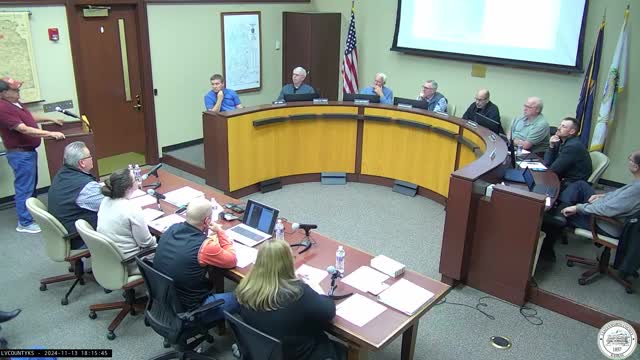Residents rally against proposed land development changes
November 16, 2024 | Leavenworth County, Kansas
This article was created by AI summarizing key points discussed. AI makes mistakes, so for full details and context, please refer to the video of the full meeting. Please report any errors so we can fix them. Report an error »

In a recent government meeting, community members voiced strong opinions regarding a proposed land development project that seeks to split existing properties into smaller lots. The discussions highlighted concerns over environmental impacts, water supply issues, and the preservation of the rural character of the neighborhood.
One resident, Mr. Guilford, defended his plans, emphasizing his commitment to maintaining the integrity of his farm and the surrounding environment. He expressed that his intentions were not to disrupt the community or harm local wildlife, stating, “I don’t plan on tearing that up. I’ve worked hard for that place.” He acknowledged the importance of responsible land management and assured attendees that he would not engage in practices detrimental to the area.
Conversely, several residents expressed their opposition to the proposed lot splits, citing potential negative consequences for the community. Cecilia Joanne Aaron, a neighboring property owner, raised concerns about water runoff from Guilford's land affecting her cattle and wildlife. She emphasized the importance of preserving the land for future generations, stating, “My grandson wants to farm… it’s been continuously in the family.”
Secret Nichols, another local resident, articulated fears that the development would lead to overpopulation and disrupt the tranquility of their rural neighborhood. She highlighted the potential increase in traffic and the strain on local infrastructure, particularly water supply, which is already a concern for many residents. “The water pressure in that area is low,” she noted, warning that additional homes could exacerbate the issue.
James Dyson echoed these sentiments, sharing his own struggles with low water pressure and the implications of adding more homes to the area. He raised concerns about the adequacy of septic systems and the overall impact on the community's resources.
The meeting underscored a significant divide between those advocating for development and those prioritizing the preservation of their rural lifestyle. As discussions continue, the community remains engaged in the decision-making process that will shape the future of their neighborhood.
One resident, Mr. Guilford, defended his plans, emphasizing his commitment to maintaining the integrity of his farm and the surrounding environment. He expressed that his intentions were not to disrupt the community or harm local wildlife, stating, “I don’t plan on tearing that up. I’ve worked hard for that place.” He acknowledged the importance of responsible land management and assured attendees that he would not engage in practices detrimental to the area.
Conversely, several residents expressed their opposition to the proposed lot splits, citing potential negative consequences for the community. Cecilia Joanne Aaron, a neighboring property owner, raised concerns about water runoff from Guilford's land affecting her cattle and wildlife. She emphasized the importance of preserving the land for future generations, stating, “My grandson wants to farm… it’s been continuously in the family.”
Secret Nichols, another local resident, articulated fears that the development would lead to overpopulation and disrupt the tranquility of their rural neighborhood. She highlighted the potential increase in traffic and the strain on local infrastructure, particularly water supply, which is already a concern for many residents. “The water pressure in that area is low,” she noted, warning that additional homes could exacerbate the issue.
James Dyson echoed these sentiments, sharing his own struggles with low water pressure and the implications of adding more homes to the area. He raised concerns about the adequacy of septic systems and the overall impact on the community's resources.
The meeting underscored a significant divide between those advocating for development and those prioritizing the preservation of their rural lifestyle. As discussions continue, the community remains engaged in the decision-making process that will shape the future of their neighborhood.
View full meeting
This article is based on a recent meeting—watch the full video and explore the complete transcript for deeper insights into the discussion.
View full meeting
